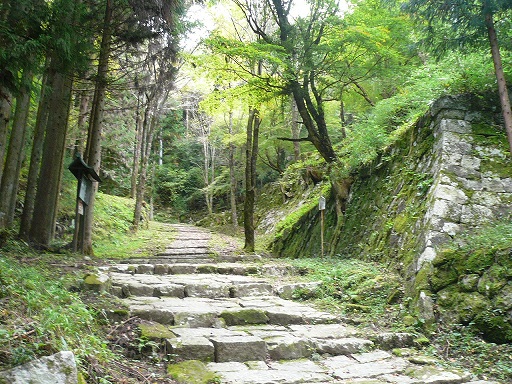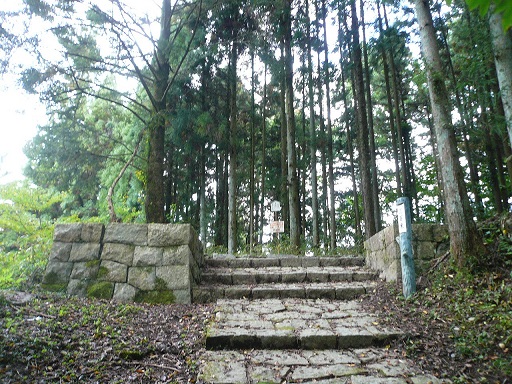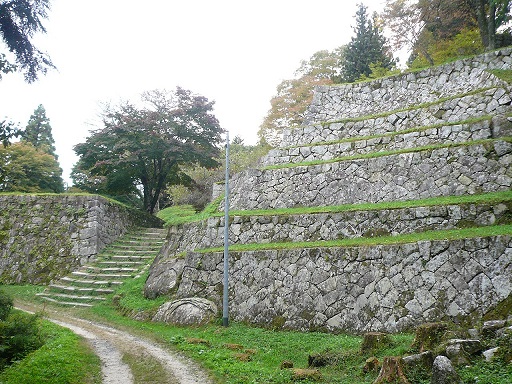|
Ruins of Iwamura Castle
|
Iwamura Castle was originally built in 1185, at the end of the Heian Age
(794 - 1185)
, by KATO Kagekado.
As Iwamura Castle was located at the boundary of the territories of ODA Family and TAKEDA Family, a couple of battels were held between them in the late 16th century.
Iwamura Castle was located at the top of Mt. Shiroyama, whose altitude is 717 meters in height.
This was the highest location among approximately 300 existing castles in the Edo Age
(1603 - 1868)
.
In the Edo Age, the palace and the government houses of the Iwamura Domain were placed at the foot of Mt. Shitroyama.
If you walk to the ruins of Iwamura Castle through Iwamura Castle Town, you will see the re-built castle buildings just after passing the castle town.
The main gate, a castle tower, and a warehouse of Iwamura Castle were re-built in 1990.
These buildings remind you of the atmosphere of Iwamura castle in the Edo Age
(1603 - 1868)
.
|
Re-built castle buildings at the foot of Mt. Shiroyama
|

|
|
|
Behind these buildings shown in the above pictures, the castle palace was located.
A historical museum was located at the site of the castle palace.
From the re-built castle buildings, a steep slope continues to the main bailey of the Iwamura Castle, located at the top of Mt. Shiroyama.
The distance is approximately 600 meters and the slope passes among trees on Mt. Shiroyama.
On the way, you will see a couple of ruins of gates covered with stone walls.
The main baileys of Iwamura Castle, located at the top of the mountain, were strictly protected by these gates.
|
The ruins of "Ichino-Mon" Gate

|
The ruins of "Toki-Mon" Gate

|
|
After passing through the "Otemon" Gate, you are in the third bailey of Iwamura Castle.
Stone walls along the main castle street were well preserved. These stone walls protected retainer's residences in the late 16th century, when a lot of battels occurred between ODA and TAKEDA families.
You will also see the site of a well. It is said that fog coming from the well covered the Iwamura Castle, when enemies surrounded the castle. The layer of fog resulted in enemies not attacking the castle.
Approximately 20 to 30 minutes walking from the historical museum at the foot of the mountain, you will see the six stairs of stone walls, which were built at the end of the Muromachi Age
(1336 - 1573)
.
The six stairs of stone walls are the symbol of the ruins of Iwamura Castle.
After passing the six stairs of stone walls, you will also see stone walls protecting the main bailey.
These stone walls were also built at the end of the Muromachi Age
(1336 - 1573)
.
|
|
At the later part of the Muromachi Age
(1336 - 1573)
, especially after 1467, Japan was in most serious confusion. Each local clan tried to expand their territory by fighting against their neighbors.
After the Edo government, "Edo Bakufu", was established in 1603, such battles between local clans were prohibited.
Time after time, all the castle buildings were lost, and only stone walls remain in the mountains.
From the main bailey, you will see the Central Japan Alps mountains in the distance. They were covered by snow in the late fall and were shining white, as if peace has continued for a long time, even since the history of Japan started.
|
|
|
How to get there
From Nagoya, take a rapid train on the JR Chuo Main Line to Ena Station. Change to a Akechi Railway train at Ena Station. Iwamura is the sixth stop from Ena.
From Iwamura Station, it will take you approximately 20 minutes to the historical museum located at the foot of Mt. Shiroyama. Another 20 to 30 minutes will be required to the main bailey of Iwamura Castle.
Other Historical Sites near by:
Iwamura Castle Town
Ruins of Naegi Castle
Ruins of Tsumaki Castle
|
|

 Home Page in Japanese: "Shane's HomePage"
Home Page in Japanese: "Shane's HomePage"

 Home Page in Japanese: "Shane's HomePage"
Home Page in Japanese: "Shane's HomePage"